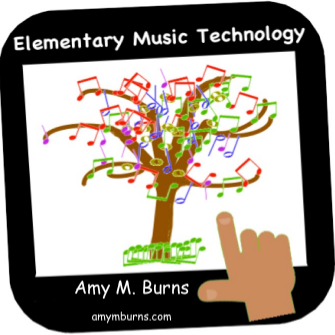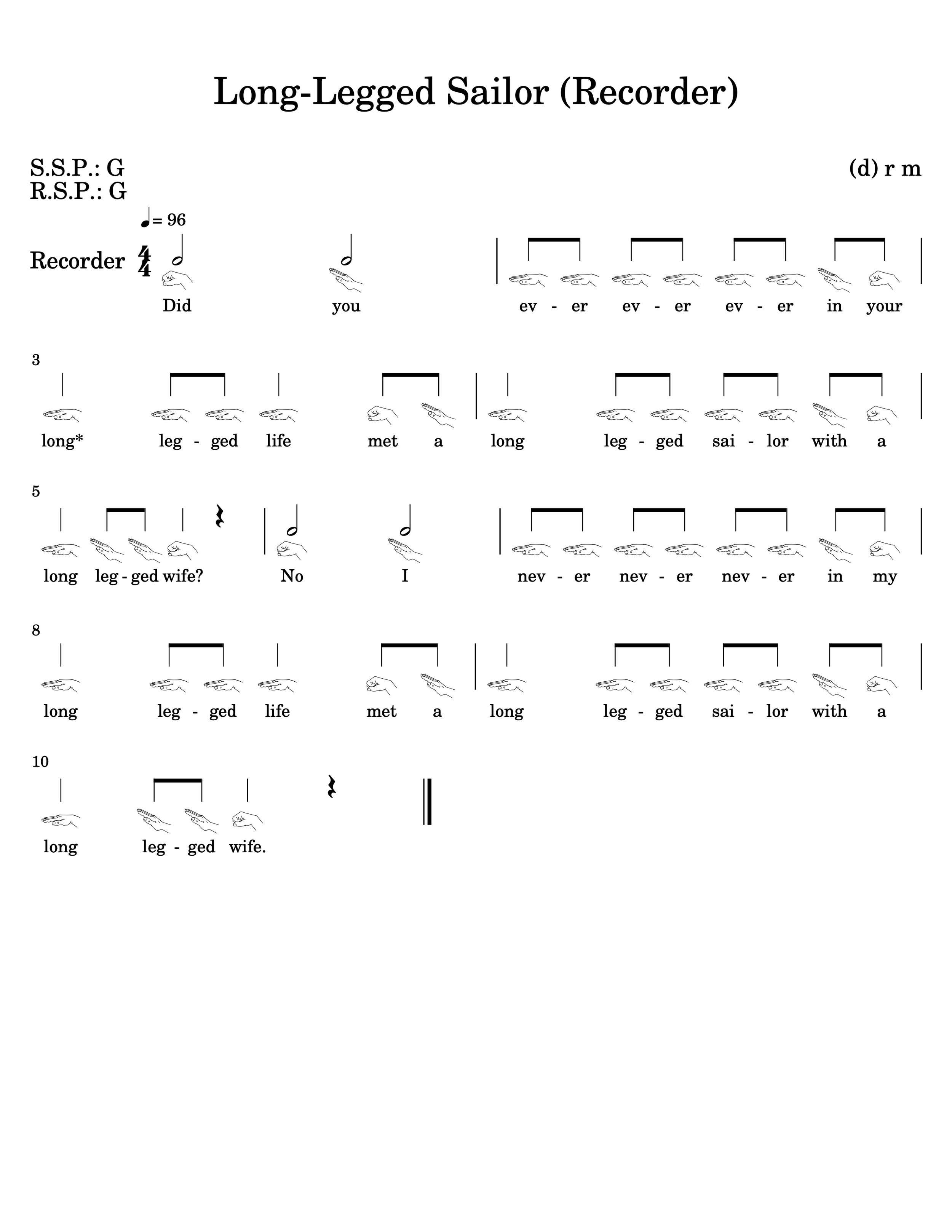Long-Legged Sailor Play-Along (Boomwhackers, Percussion, and Recorder) and Manipulatives
This post and play-along video go back three years. During the summer of 2022, my goal was to create play-along videos to songs inspired by my Kodály and Orff Schulwerk training. Long-legged Sailor is a favorite in my elementary music classroom. In this video, I slowly add an instrumental part with each verse.
Long-Legged Sailor (Meter of 4, half notes, quarter notes, eighth notes, and quarter and whole rests, D-R-M Tonal Pattern)
The fourth play-along video is “Long-Legged Sailor” and the lesson is included in this blog. I opted to show both of the versions that I have found of this song:
The words begin with “Have you…” and use the word “met” consistently throughout the song.
The words begin with “Did you…” and use the words “meet” and “met” throughout the song.
I opted to begin with the half-note rhythm, but you could change that to state it should be fermatas and teach about the fermata. It depends on the focus and concepts of the lesson you would like to teach.
I used the version with the following movements: Long-legged, short-legged, knock-kneed, bow-legged, and cross-legged. You can choose to use the same version or to leave some of these out.
The melody is demonstrated first followed by the same verse being sung by your class. Then, when the short-legged verse comes up, they can sing and play the bass line. When the knock-kneed version comes up, they can sing or play the recorder (with the bass line still playing). When the bow-legged verse comes up, they can sing, play the recorder, add the boomwhackers, and continue to play the bass line. When the final verse (cross-legged) comes up, they can sing, play the recorder, play the boomwhackers, play the bass line, and add the classroom percussion instruments of drums and triangles.
For each verse, students can perform on instruments, sing, or perform the movements. This song lends itself to a classroom with many or few students and with multiple to very little instrumentation.
The accompaniment is intuitive as it is Do Sol Sol, Sol repeated four times followed by a Do Sol Do rest. The percussion line is played by the drum and triangle. This includes rolls on the half-notes in the drums and then a basic ta ti-ti ta ta rhythm accompaniment. The triangle plays a quarter note on the words “met a” (or “meet a” depending on the version) and after the word “wife”. The recorder part performs the notes B A and G.
The melody line is introduced first, followed by the bass line, then the recorder, boomwhacker, classroom percussion. and then finished with all lines performing together.
Melody
I have taught this with grade 3 and above as a parallel to their recorder study. This lends itself well if you are teaching mi, re, do on recorder as the first three notes. Traditionally in the key of G, the notes would be taught in the sequence of B, A, and then G with this song introducing or reinforcing/practicing the note G.
When teaching this melody, I begin with M R D tonal pattern warmups. I then focus on the repeated pattern of M R-R D. We then transfer that from hand signals and singing to the recorder on the notes B A-A G. This occurs every time we sing “_ __ wife” or “_ __ life”. We also reinforce the rhythm pattern of ta ti-ti ta rest.
These hand signals were found as a member of Midnight Music.
Assessment
As the students learn the melody, they will challenge themselves (if they feel ready) by trying to perform the entire melody on their recorder. Some of my students take right to this. Some need assistance in hearing and decoding the melody. And some feel most comfortable only playing the B A-A G or M R-R D portion of the melody. My only assessment is the M R-R D portion, so if they continue with the challenge, then I encourage it greatly but do not expect all to be able to do this yet.
The assessment is performed in groups. I will play and sing the portion of the verse and a small group of students will play the M R-R D when it comes in the song. I will also have some students sing while others play to assess both recorder performance and singing performance.
Movement Activity
My students love this movement activity. In my class, we perform the song the following way and it is the movement that helps the students listen and learn the lyrics well. Plus, those students who do not like to sing, tend to love to perform the movements. The movements are also adapted for those who cannot stand.
Long-Legged - They stand or sit with their arms stretched above their heads.
Short-legged - They are on their knees or they sit and crouch down.
Knock-Kneed - They stand or sit with their knees together.
Bow-Legged - They stand with one leg curved as a bow with that leg’s foot resting on the other leg’s knee. Or they sit with one arm curved resting on their hip.
Cross-Legged - They cross their legs while standing or they sit and cross their arms.
Performing the Parts
Melody
After learning the M R-R D pattern and the movements, I would split the class so that some sing the entire melody and some perform the movements. Others would play the M R-R D pattern on a pitched instrument. We would then switch the groups around so that they all experience performing a portion to all of the melody.
Recorder and Boomwhackers
As they become familiar with the melody, they can transfer it to boomwhackers and to the recorder, either still performing just the M R-R D pattern or challenging those students to decode and perform the entire melody on their recorders.
Bass Line
The bass line is a basic line of Do Sol Sol, Sol repeated four times followed by a Do Sol Do rest. Have all of the students perform this bass line starting with their laps, tapping with their left hand, then right hand, then left, and then right. The pattern would be LRLR | LRLR | LRLR | LRL (rest). They would transfer this pattern to DSS,S | DSS,S | DSS,S | DSD (rest). In this example, the pitch do would be the note G and the pitch sol would be the notes D and D,.
If the students have trouble identifying left from right, which is normal, I give them a scrunchy or rubber band to put on their right wrist to help with this.
Classroom Percussion: Drum and Triangle
After learning all of the other parts, the students would learn the drum and triangle parts. The drum part begins with the roll on the half notes. We would perform this on our laps. We then would read and perform the rhythm patterns of ta ti-ti ta ta four times and finish with one final ta ti-ti ta rest.
The triangle plays a quarter note on the words “met a” (or “meet a” depending on the version) and after the word “wife”. Sometimes, it is challenging for the student to play on the words “met a” or “meet a” because they are two words to one quarter note. Therefore, I will teach them to play after the word, “life”. Then, we can practice that with counting and snapping first: 1 2 3 4 5 6 7 “snap”, 1 2 3 4 5 6 7 “snap”. Then, with counting and words: 1 2 3 4 5 6 life “snap”, 1 2 3 4 5 6 wife “snap”. Then, transfer the snaps to the triangle.
WHAT IF YOU DON’T HAVE ENOUGH INSTRUMENTS FOR YOUR STUDENTS?
That is where this lesson can be accomplished with xylophones, boomwhackers, tone chimes, tone bars, and virtual instruments. Since the melody has two pitches, you can supplement instruments that can play high and low, or the pitches of G and E, so that more students can perform. Virtual websites like Playxylo.com, my Scratch Boomwhackers site, my Scratch Classroom Percussion site, and Dr. Musik’s website help when you might not have enough instruments, but you do have access to devices. This also helps students who cannot hold mallets in a traditional way so that they can make music alongside their classmates.
MANIPULATIVES
Where Can I Find the Parts?
All of the parts and the video are included in the manipulatives found here at
https://buymeacoffee.com/elmusedtech/extras

















